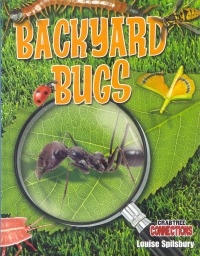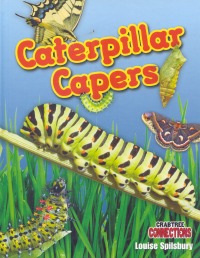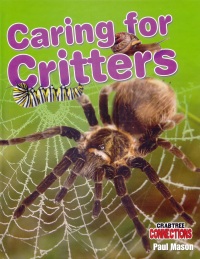| ________________
CM . . . . Volume XVIII Number 20 . . . . January 27, 2012
excerpt:
Crabtree Publishing Company’s series for the youngest readers, “Crabtree Connections,” includes these three titles about bugs. They introduce recognizable creatures that kids might encounter in their neighborhood. The presentations are laid out in bright and attractive double-page spreads with large type and larger-than-life sized, full color photos. Usually a single key detail is pointed out in an insert close-up. Backyard Bugs offers 4-6 basic facts about each of eight creatures while Caterpillar Capers shows the complete life cycle of just one. Caring for Critters focuses on aspects of keeping particular bugs as pets. Each book includes a Table of Contents, Glossary, Index and lists of websites and books for further reading. The layout makes these titles fine early reference books that will allow beginning readers to learn how to find information in a nonfiction book. Content-wise, Caterpillar Capers includes sufficient detail for the young reader to follow the progression from egg to caterpillar to butterfly. It adds interesting facts: “some caterpillars are very spiky; caterpillars grow very quickly; caterpillars can walk upside down.” Backyard Bugs highlights details such as “many ladybugs have seven black spots”; “ants can carry food that is heavier than they are.” The page about Shield Bugs could have been improved with a photo that matches the text more closely: the reader is told that “Shield bugs are the same color as leaves”, but a bold black and red bug is pictured on a green leaf. While those two titles will serve as good basic introductions, the brief format does not work as well for Caring for Critters. Details are too sketchy to be really useful if the book’s purpose is to help kids keep bugs safely in captivity. In the case of the ant farm, for example, only three details about food are included. The ‘special house’ called an ant farm is not shown or described. The page about grasshoppers mentions habitat needs, but not food. The spider caution about preventing escape, or “imagine the scream if your mom saw it in the bathtub!” unnecessarily perpetuates a stereotypical fear factor. More troublesome are the warnings about the fragile nature of the praying mantis, the spiny leaf insect, and about the bite of centipedes and stings of scorpions. In particular, telling a young child to “pick a scorpion with a thin tail and large claws….its venom is not harmful to humans” seems like a recipe for confusion and possible harm. These are obviously unsuitable as pets; rather kids should be encouraged to observe them in the wild, and leave them there. Nowhere in the book is the reader encouraged to release any of these animals after a short time, missing an opportunity to teach respect for nature. This topic is more suited to older readers who can understand and appreciate the needs of these animals. All of these books are useful as starting points for kids curious about bugs. Backyard Bugs - Highly Recommended. Gillian Richardson is a freelance writer living in BC.
To comment
on this title or this review, send mail to cm@umanitoba.ca.
Copyright © the Manitoba Library Association. Reproduction for personal
use is permitted only if this copyright notice is maintained. Any
other reproduction is prohibited without permission.
NEXT REVIEW |
TABLE OF CONTENTS FOR THIS ISSUE
- January 27, 2012.
AUTHORS |
TITLES |
MEDIA REVIEWS |
PROFILES |
BACK ISSUES |
SEARCH |
CMARCHIVE |
HOME |
||||||||||||||


